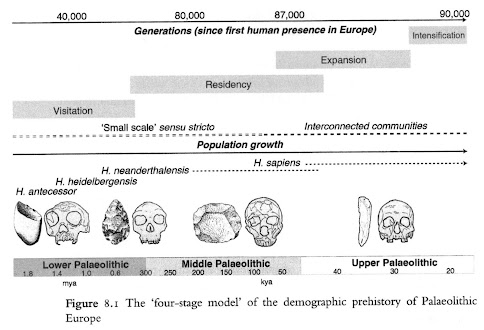I've finished reading this new book by Jennifer C. French, an archaeologist, and will sum up my reactions. The text is academic in style, and most of the book is a recapitulation and discussion of research papers on the topic. It is an effort to describe ancestral trends and living conditions in Europe from about two million years ago to about 15,000 years ago, and a paucity of relevant data results in a murky picture until the more recent period. The species described are hominins, i.e. modern humans and extinct human species, but not other primates. The research is conducted through three primary sources: stones, bones and genes. The stones are rock artifacts, usually tools or weapons, and, more recently, figurines such as the Willendorf Venus. The bones are bones and teeth from archaeological digs, and genes, when available, contain genetic information. There is also some use of research on modern hunter-gatherers, though that is an unreliable model, since most of them have had some contact with culturally modern humans. The chart below sums up the main research findings:

The earliest known Europeans were H. antecessor and H. heidelbergensis. They may have moved in and out of Europe intermittently, starting in Africa. H. neanderthalensis is the only Homo species thought to have originated outside Africa and mated with both the Denisovans, who lived in western Asia, and H. sapiens in Europe and elsewhere. Most of the early humans who migrated from Africa traveled to Asia and never went to Europe. Some returned to Africa and reemerged later.
Until H. sapiens arrived, the human population in Europe was quite small. H. neanderthalensis was subject to food shortages and infertility. Because they had bulky bodies, they required more food than modern humans. They appear to have been less mobile than us, and their extinction may have been related to inadequate food supplies. In the skeletal remains there are signs of violence at an early age, and there is more evidence of cannibalism than in H. sapiens, though the context for that cannibalism isn't known. The genes of H. neanderthalensis indicate periods of inbreeding. H. sapiens behaved somewhat differently from H. neanderthalensis and appears to have been both more social and more mobile. That allowed them to maintain large networks that were beneficial during hard times, and their population increased. French focuses somewhat on nutrition, disease and fertility to explain population fluctuations. She seems reluctant to say that H. sapiens may have had a significant survival advantage because of increased eusocial behavior compared to earlier species, but, to my way of thinking, that would be the best single explanation of how they survived and flourished during a period of wide climate fluctuations in the Ice Age.
Overall, I found this book interesting and informative, but I disliked the academic writing style. Also, the feeling that I got was that the events discussed were so far in the past as to render them inaccessible for all practical purposes. We may never have a clear picture of what human culture was like in Europe 35,000 years ago, so the attempt to study it may be futile. For me, this book is a reminder of how little we know and of how little we may ever know. I should also note that others may not want to read the book, if only because it is an expensive college textbook, and you will probably never see it in a local bookstore or library. The Kindle edition currently costs $80.
